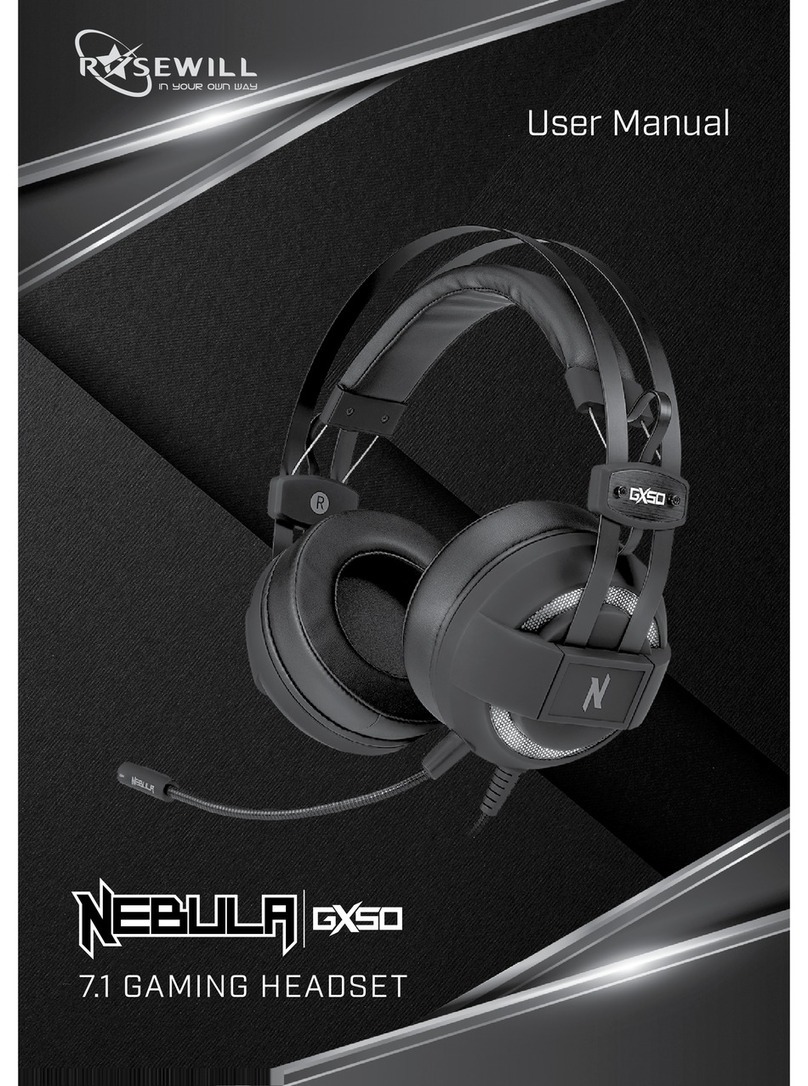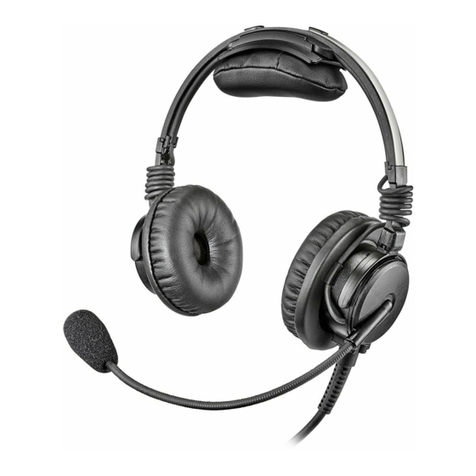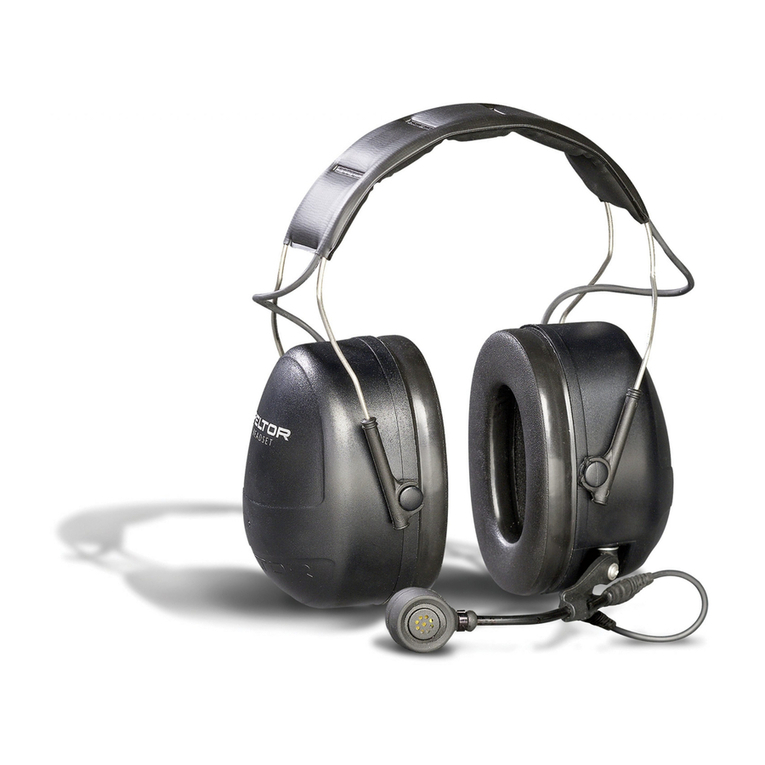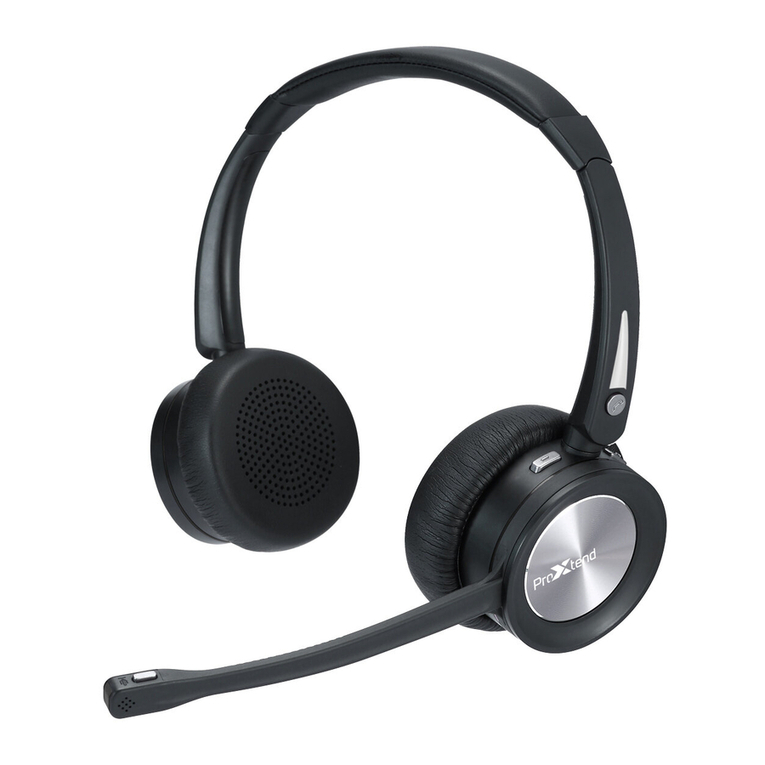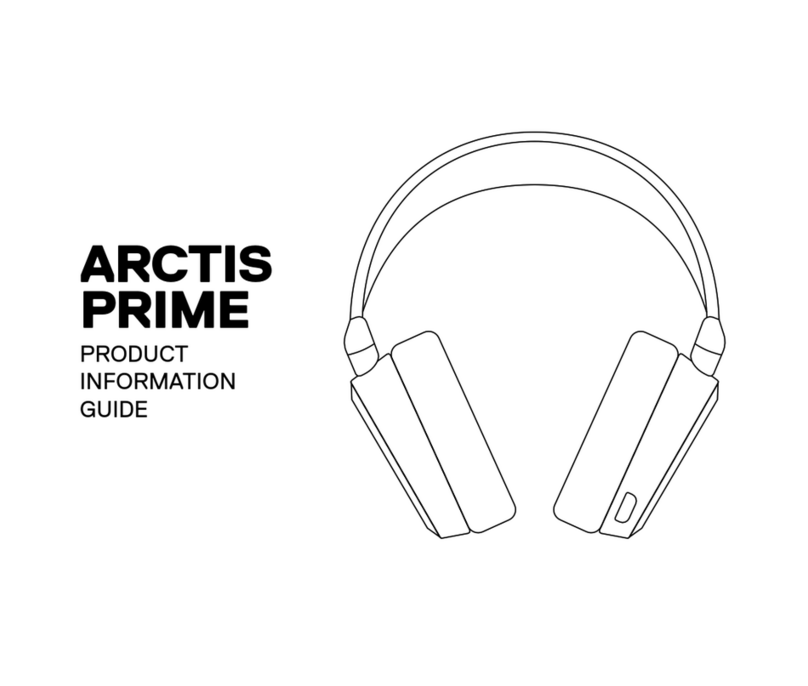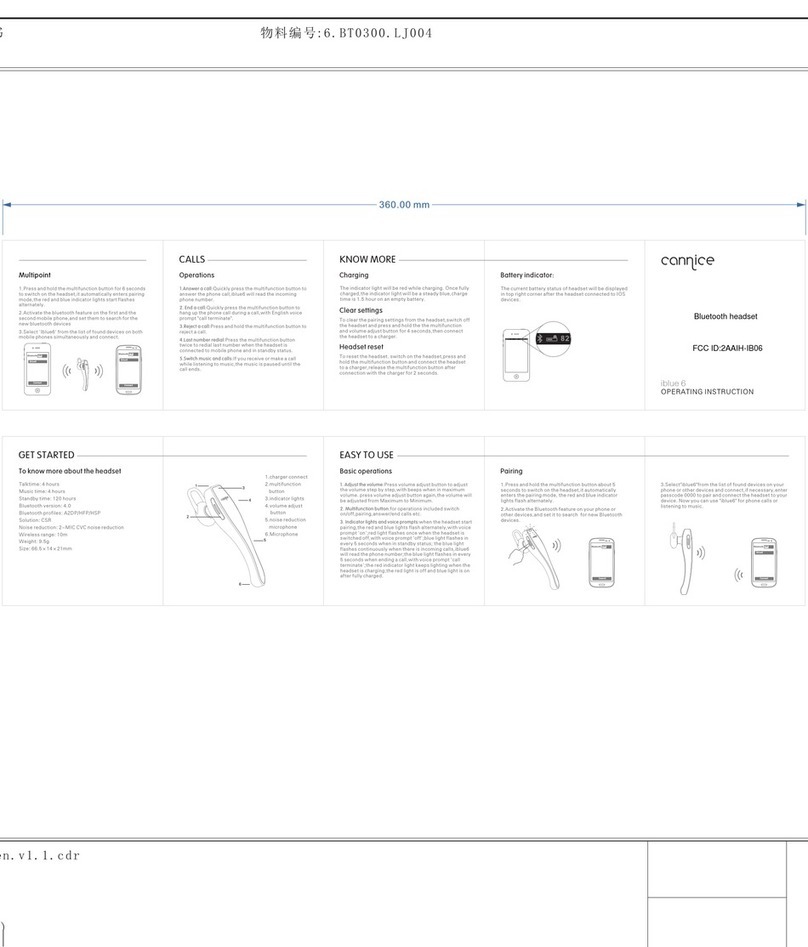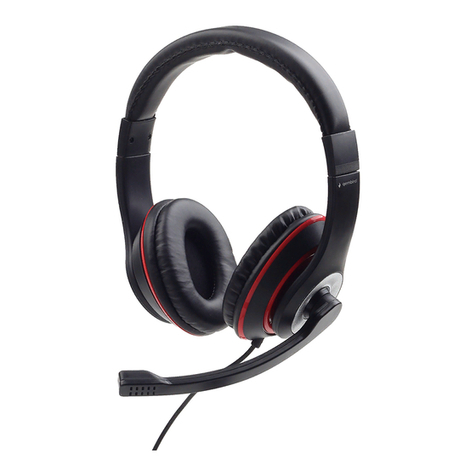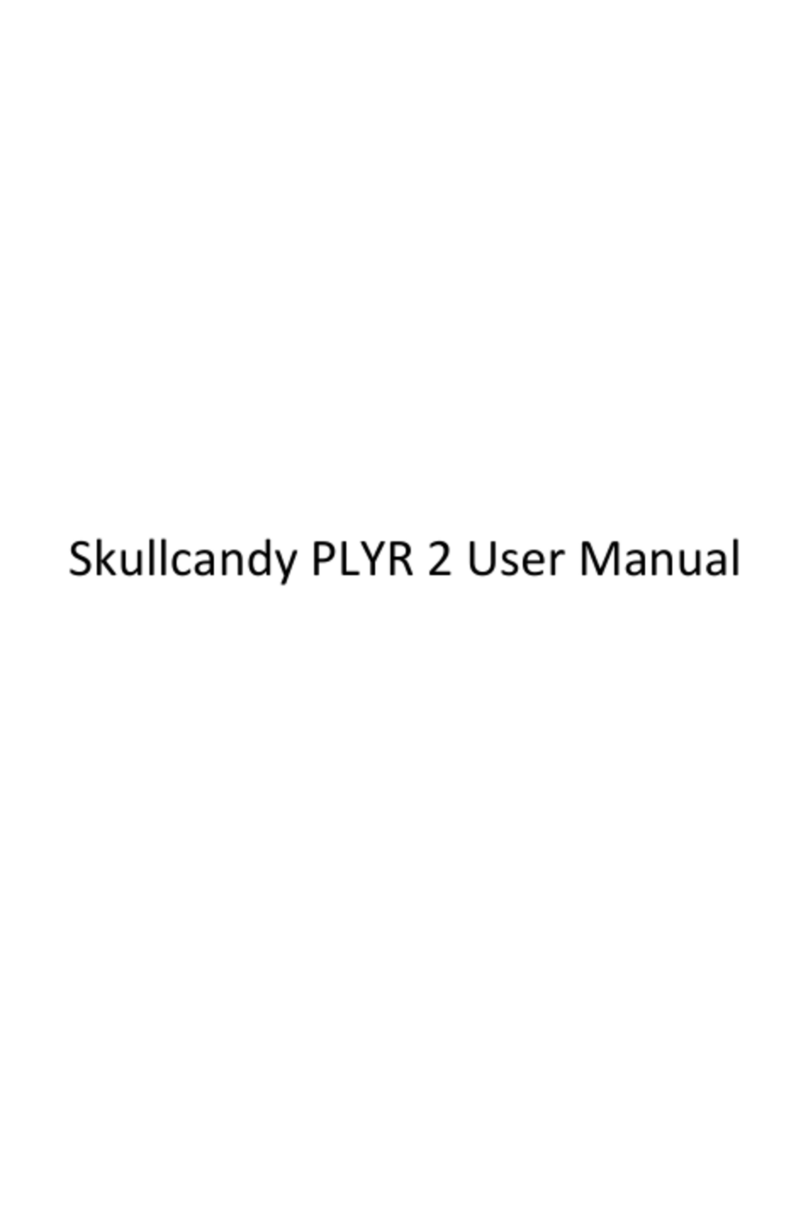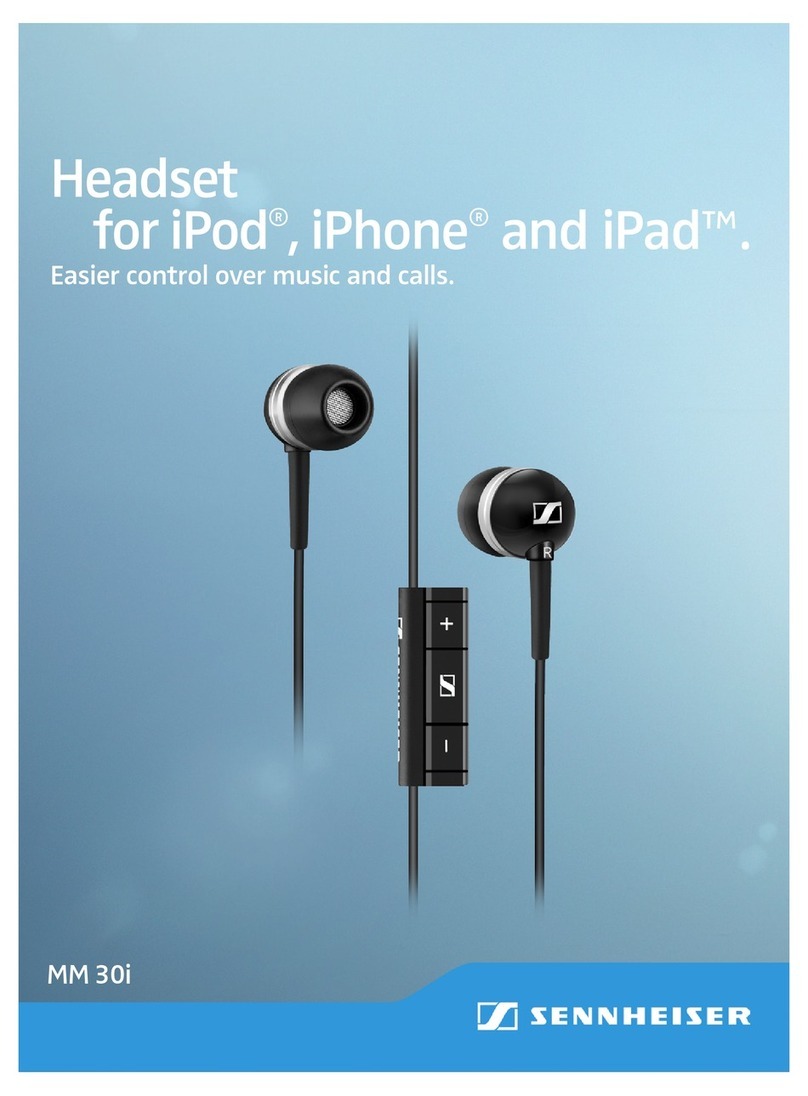Klein Tools AESEM1S User manual

Situational Awareness
Bluetooth®Earmuffs
INSTRUCTION MANUAL
FRANÇAIS pg. 21
ESPAÑOL pg. 11
ENGLISH
• NEED FEATURES
• NEED FEATURES
• NEED FEATURES
• NEED FEATURES
• NEED FEATURES
• NEED FEATURES
• NEED FEATURES
• NEED FEATURES
AESEM1S
FPOFPO

2
GENERAL SPECIFICATIONS
Klein Tools Situational Awareness Bluetooth Earmuffs enable users to remain
cognizant of their surrounding environment while expertly incorporated Bluetooth
technology lets the user enjoy music simultaneously without compromising the
user's hearing protection of up to 21dB NRR. The vented headband design and soft-
foam ear cushions allow for a cool comfortable fit.
• Hearing Protection: 21dB NRR (Noise Reduction Rating)
• Wireless Compatibility: Devices with Bluetooth®Version 5.0
• Wireless Connection Range: 32.8 ft. (10 m) in open space
• Frequency Response: 20Hz - 20kHz
• Maximum Bluetooth Volume : 92 dBA
• Support Proles: A2DP v1.3/AVRCP v1.6/HFP v1.7/HSP1.2/GAVDP1.3
• Battery Type: Internal, Li-Ion, 3.7V / 500mAh (1.85Wh)
• Runtime: Approx. 22 hours @ 100% Ambient & 100% Bluetooth Volume
• Charging Requirements: Maximum 5V DC, Minimum 0.6A
• Charging Time: Approx. 2 hours
• Dimensions: 6.18" × 7.03" × 3.90" (156.9 × 178.5 × 99 mm)
• Weight: 15.38 oz. (436 g)
• Operating Temperature: 14° to 140F (-10° to 60°C)
• Charging Temperature: 32° to 113°F (0° to 45°C)
• Storage Temperature: -4° to 140°F (-20° to 60°C)
• Relative Humidity: <85% non-condensing
• Drop Protection: 6.6' (2 m)
• Ingress Protection (IP) Rating: IPX4 Dust & Water Resistant
• Certications:
FCC, IC, DOE/CEC, NrCan, NOM-IFETEL
• FCC ID: 2AI28-AESEM1S
• IC: 21655-AESEM1S
• IFETEL: ???
Specifications subject to change.
ENGLISH
The Bluetooth®word mark and logos are registered trademarks owned by Bluetooth SIG, Inc. and
any use of such marks by Klein Tools, Inc. is under license.

3
WARNINGS
Read, understand, and follow these instructions to ensure safe operation. Keep these
instructions for future reference.
These hearing protectors help reduce exposure to hazardous noise and other loud sounds.
Misuse or failure to wear hearing protection at all times that you are exposed to noise may
result in hearing loss or injury.
• Inspect earmuffs before each use; damage to the earmuffs can reduce noise reduction
performance.
• Improper fit of this device will reduce its effectiveness in attenuating noise. Consult the
FITTING EARMUFFS section for best protection.
• Do not bend or reshape the headband as this will cause a reduced clamping force reducing
the specified NRR (Noise Reduction Rating).
• Prolonged exposure to high volumes can cause hearing damage. It is the responsibility of
the user to set the audio input level to the recommended volume. See table in FEATURE
DETAILS section for noise exposure levels.
• DO NOT use this product in situations that require special attention: using noise reduction
equipment and listening to audio can reduce awareness of the surrounding environment.
Failure to observe these warnings can result in risk of re or electric shock.
• DO NOT use the product if it is damaged or modified. Damaged or modified batteries may
exhibit unpredictable behavior resulting in fire, explosion, or injury.
• Risk of fire and burns. DO NOT open, crush, heat above specified maximum temperature or
incinerate. Prolonged exposure to direct sunlight can result in elevated temperatures
• DO NOT immerse in water or other liquids
• Properly seal the charging port cover to achieve specified water & foreign object ingress
protection. Keep seal free of dirt, oil, sand, or other material that interferes with proper
sealing. Failure to do so can result in risk of fire or electric shock.
• DO NOT open the charging port cover if wet or in a wet environment. Thoroughly dry the unit
and the seal around water-resistant cover completely before opening water resistant cover.
• DO NOT subject to impacts or drops greater than 6.6ft. (2m). Drops larger than this may
not show signs of damage, but internal components may have been compromised. It is
advisable to replace the unit if any such severe events occur
• DO NOT attempt to repair the product or charging cable. There are no user-serviceable parts.

4
ENGLISH
FEATURE DETAILS
1. Bluetooth Volume Knob
2. Ambient Volume Knob
3. Omni-Directional Microphone
4. Multi-Function Button (MFB)
5. Bluetooth Microphones
6. Silicone Port Cover
7. USB-C Charging Port
8. Indicator LED
9. USB-A to USB-C Charging Cable
10. Carrying Bag
1
2
4
3
6
5 5
7
8
9
NOISE EXPOSURE VALUES
EXPOSURE
TIME
EXPOSURE
LEVEL PER
NIOSH
RECOMMENDED
EXPOSURE
LIMIT
EXPOSURE
LEVEL
PER OSHA
PERMISSIBLE
EXPOSURE
LIMIT
8 hours
85 dBA 90 dBA
4 hours
88 dBA 95 dBA
2 hours
91 dBA 100 dBA
1 hour
94 dBA 105 dBA
30 minutes
97 dBA 110 dBA
15 minutes
100 dBA 115 dBA
See www.cdc.gov/niosh/topics/noise/
reducenoiseexposure for more details.
FPOFPO
SYMBOLS ON PRODUCT
Warning or
Caution
Risk of
Electrical Shock
Read Instructions
FCC: Conforms
with particular
Code of Federal
Regulations
Bluetooth
®
SIG
Certied
FPOFPO
10

5
NOISE REDUCTION RATING (NRR)
The NRR for the AESEM1S Situational Awareness Bluetooth Earmuffs is 21dB. It is tested
and in accordance with ANSI S3.19-1974. To ensure adequate hearing protection, the
earmuffs must be properly fitted according to the FITTING EARMUFFS section.
ANSI S3.19-1974 TESTING
Frequency (Hz) 125 250 500 1000 2000 3150 4000 6300 8000 NRR
Mean Attenuation 34.3 31.7 36.1 35.3 37.7 40.4 41.0 46.3 45.8 21
Standard Deviation
3.9 3.0 3.3 3.6 3.9 4.3 3.6 4.1 2.8
NOTE: The above table is based on a headband force of 12N.
The level of noise entering a person’s ear when the hearing protector is worn
as directed, is closely approximated by the difference between the A-Weighted
environmental noise level and the Noise Reduction Rating (NRR).
EXAMPLE:
• The environmental noise level as measured at the ear is 89dB(A).
• The NRR is 21dB.
• The level of noise entering the ear is approximately equal to 68dB(A).
CAUTION: For noisy environments dominated by frequencies below 500 Hz, the
C-weighted environmental noise level should be used.
NOTE: Although hearing protectors can be recommended for protection against the harmful
effects of impulsive noise, the Noise Reduction Rating (NRR) is based on the attenuation of
continuous noise and may not be an accurate indicator of the protection attainable against
impulsive noise such as gunfire. The Environmental Protection Agency uses the Noise
Reduction Rating (NRR) as a rating of a hearing protector’s noise-reducing performance.
Klein Tools cannot guarantee the suitability of the NRR as a method of rating protection as
protection relies on the level and exposure of sound and how well a product fits.
AUDIO INPUT LEVEL
The audio level in the hearing protector is dependent on the audio input level.
To prevent harmful noise levels, the AESEM1S Situational Awareness Bluetooth
Earmuffs automatically default to 85dB(A) when wirelessly connected to a music
device. If the hearing protector is either wirelessly connected or wired to a music
device with a high audio output level, it is the user’s responsibility to set the audio
input level to safe level.
See table in FEATURE DETAILS section for noise exposure levels.

6
ENGLISH
OPERATING INSTRUCTIONS
CHARGING EARMUFFS
1. Open the Silicone Port Cover
6
to access the USB-C Charging
Port
7
.
2. Using the included USB-A to USB-C charging cable
9
, plug the
USB-C end into the USB-C Charging Port
7
of the earmuffs
while plugging the USB-A end into an appropriate charging
source, such as a third party certified USB to AC wall adapter
(not included, see GENERAL SPECIFICATIONS for charging
requirements).
3. While the earmuffs are charging (0-99%), the Indicator LED
8
will breathe (dim to bright) red, and will illuminate solid green
when fully (100%) charged.
FITTING EARMUFFS
1. Fold out the earcups from the storage position by extending the
slider arms (FIG. 1).
2.Place earmuffs on the head positioning the earcups over
each ear (FIG. 2). The inner headband is labeled (R or L) for
convenience.
3.When placing the earcups over the ears be sure to:
• Completely cover the ear, the ears should never be exposed
(FIG. 3).
• Avoid obstructions (such as hair) that would prevent a firm
seal (FIG. 4).
• Adjust the slider arms up or down to tighten or loosen
the headband until a hugging seal and comfortable fit is
achieved (FIG. 5).
FIG. 1
FIG. 2
FIG. 3
FIG. 4
FIG. 5

7
OPERATING INSTRUCTIONS
POWER ON/OFF
ON: Press and hold the Multi-Function Button
4
for 1.5 seconds. “Power ON”
voice prompt will be heard and the LED will turn solid green for one second, then
turn off.
OFF: Press and hold the Multi-Function Button
4
for 3 seconds. “Power OFF”
voice prompt will be heard and the Indicator LED
8
will turn solid red for one
second, then turn off.
BLUETOOTH®PAIRING
After successfully powering on, the earmuffs will automatically enter Bluetooth®
pairing mode. “Pairing” voice prompt will be heard and the Indicator LED
8
will
breathe (dim to bright) blue every three seconds.
1.Ensure Bluetooth is enabled on your device and it has discovered “Klein Muffs”
in the pairing list.
2.Select “Klein Muffs” and upon successful connection, “Connected” voice
prompt will be heard and the Indicator LED
8
will turn solid blue for three
seconds, then turn off.
3.In the event pairing fails, double press the Multi-Function Button
4
to
manually enter Bluetooth pairing mode.
NOTE: The earmuffs will automatically attempt to re-connect to the last
known paired wireless device when turned on, but are ready to pair with any
Bluetooth compliant device within two minutes of powering on if the last
paired device is not detected.
AUTO POWER-OFF
After 8 hours of use, the AESEM1S will automatically power off.
MUSIC OPERATION
Play/Pause: Single press the Multi-Function Button
4
.
Next Track: Double press the Multi-Function Button
4
.
Previous Track: Triple press the Multi-Function Button
4
.
Volume Up: Scroll up on the Bluetooth Volume Knob
1
.
Volume Down: Scroll down on the Bluetooth Volume Knob
1
.

8
ENGLISH
OPERATING INSTRUCTIONS
AMBIENT OPERATION
Volume Up: Scroll up on the Ambient Knob
2
.
Volume Down: Scroll down on the Ambient Knob
2
PHONE CALL OPERATION
Answer/End Calls: Single press the Multi-Function Button
4
.
Reject Call: Press and hold the Multi-Function Button
4
for one second.
Hold Current Caller and Answer New Incoming Call: Double press the
Multi-Function Button
4
.
Switch Between Two Active Calls: Double press the Multi-Function Button
4
.
End Current Call and Other Call on Hold: Press and hold theMulti-Function
Button
4
for one second to end new call, then single press to end initial call.
CLEANING
The earmuff shell and cushion can be gently wiped clean with lukewarm mild soapy
water and dried with a soft cloth without rubbing.
Do not submerge earmuffs in
water or treat with abrasive cleaners or solvents.
STORAGE
If earmuffs are to be left unused for an extended period of time, charge before storing
and recharge periodically during storage to maintain battery’s capacity/life.
MAINTENANCE
Regularly inspect earmuffs and ear cushions for excessive wear such as tears and/
or visible cracks. Replace earmuffs if tears and/or cracks are visible on the shell and/
or cushion. Replace earmuffs if there is a noticeable change in the fit and no longer
sealing firmly against your head.

9
COMPLIANCE
FCC COMPLIANCE
This device complies with part 15 of the FCC RULES. Operation is subject to the
following two conditions: (1) this device may not cause harmful interference, and
(2) this device must accept any interference received,including interference that
may cause undesired operation.
NOTE: Changes or modifications not expressly approved by the party responsible
for compliance could void the user’s authority to operate the equipment.
This equipment has been tested and found to comply with the limits for a Class B
digital device, pursuant to part 15 of the FCC Rules. These limits are designed to
provide reasonable protection against harmful interference in a residential installation.
This equipment generates, uses and can radiate radio frequency energy and, if not
installed and used in accordance with the instructions, may cause harmful interference
to radio communications. However, there is no guarantee that interference will not
occur in a particular installation. If this equipment does cause harmful interference to
radio or television reception, which can be determined by turning the equipment off
and on, the user is encouraged to try to correct the interference by one or more of the
following measures:
• Reorient or relocate the receiving antenna.
• Increase the separation between the equipment and receiver.
• Connect the equipment into an outlet on a circuit different from that to which the
receiver is connected.
• Consult the dealer or an experienced radio/TV technician for help
FCC RF EXPOSURE STATEMENTS:
This equipment complies with FCC radiation exposure limits set forth for an
uncontrolled environment and meets the FCC RF Exposure Guidelines.
This device must not be co‐located or operated in conjunction with any other
antenna or transmitter.

10
ENGLISH
CUSTOMER SERVICE
KLEIN TOOLS, INC.
450 Bond Street Lincolnshire, IL 60069 1-800-553-4676
[email protected] www.kleintools.com
WARRANTY
www.kleintools.com/warranty
DISPOSAL /RECYCLE
Do not place equipment and its accessories in the trash. Items must be
properly disposed of in accordance with local regulations. Please see
www.epa.gov/recycle for additional information.
COMPLIANCE
IC COMPLIANCE
This device contains license-exempt transmitter(s)/receiver(s) that comply with
Innovation, Science and Economic Development Canada’s license-exempt RSS(s).
Operation is subject to the following two conditions: (1) This device may not cause
harmful interference, and (2) This device must accept any interference received,
including interference that may cause undesired operation of the device.
This device complies with RSS-247 of Industry Canada. Operation is subject to the
condition that this device does not cause harmful interference. This Class B digital
apparatus complies with Canadian ICES-003.
IC RADIATION EXPOSURE STATEMENT:
The equipment complies with SAR limits set forth for an uncontrolled environment
and meets the RSS-102 of the IC RF Exposure Rules. This transmitter must not be
co-located or operating in conjunction with any other antenna or transmitter.
IFETEL REPORT
For use in Mexico, the operation of this equipment is subject to the following two
conditions: (1) This equipment or device does not cause harmful interference and
(2) this equipment or device accepts any interference, including that which can cause
undesired operation.
Table of contents

